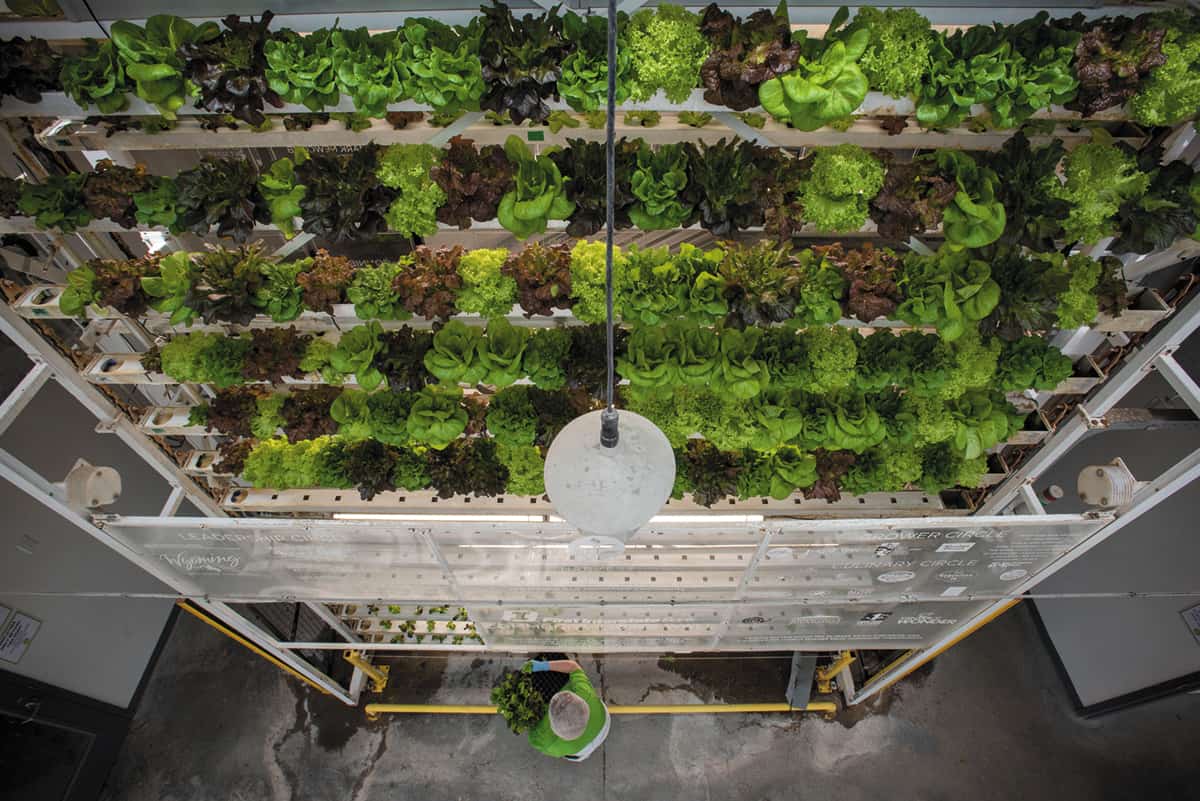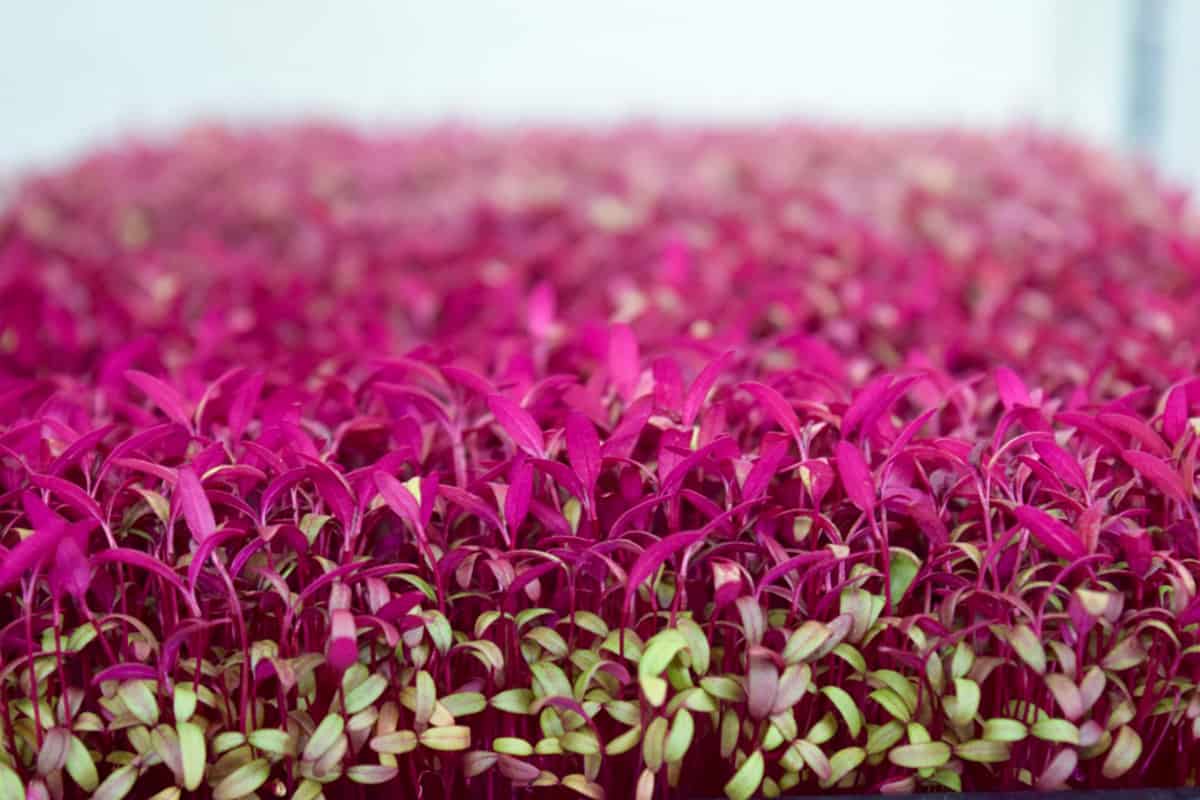By Molly Absolon // Photography by Bradly J. Boner and Delancy Hively
—
MAD Mountain Greenery’s farm is not your typical agricultural operation. Housed in a carpeted 200-square-foot room on the second floor of an office building in downtown Driggs, MAD Mountain harvests 10 to 12 pounds of microgreens a week from its new-age farm.
“I think our landlord was a little nervous at first,” says Delancy Hively, who runs MAD Mountain with her husband, Matt. “He worried that there would be dirt and water everywhere.”
But it’s not that kind of farm.
Trays of pink amaranth, purple radishes, and emerald green sunflower and fava beans are stacked under grow lights at one end of the space where the temperature and humidity are carefully monitored to maintain ideal growing conditions. In the corner, the Hivelys have a sink for washing their produce and a large table on which they harvest their crops. The compact indoor farm allows the couple to grow their microgreens year-round, providing fresh produce to restaurants with some left over for retail sales.
Likewise, Huidekoper Ranch in Wilson grows its microgreens in an unlikely place. Its trays of plants are stacked on racks in the ranch’s pumphouse, a 10-by-12-foot space that is partially underground and smells of warm dirt and basil.
Mini Marvels
Unlike sprouts—which are simply the seed and root of a newborn plant, without any leaves—microgreens are baby vegetables and herbs that are harvested when their first true leaves appear. Most microgreens are between 1 and 3 inches tall and are ready for harvest anywhere from seven to twenty-one days after germination.
“Microgreens have been around since the 1980s,” Matt Hively says, “but they are just starting to gain traction. People are obsessed with super foods, and microgreens are the newest superfoods.” He goes on to say that the nutritional value of microgreens is higher than in full-grown plants in almost every category.
Pretty much any vegetable or herb can be used as a microgreen. Vertical Harvest in Jackson grows up to 25 varieties, ranging from rock chives and dill to radishes, chervil, and basil. All three of our region’s microgreen producers say their most popular plants are sunflower, radish, and pea shoots.
“People know what to expect with sunflowers, radishes, and peas,” says Brent Tyc, head farmer at Huidekoper Ranch. “The flavor is a combination of nutty, spicy, and sweet. Plus, these plants are cheaper, making the microgreens more affordable.”
Micro Goes Mainstream
Although you can find microgreens in grocery stores like Whole Grocer in Jackson or Barrels and Bins in Driggs, most of the plants grown here are destined for restaurants, where chefs covet them for their flavor and color. A pinch of microgreens adds a burst of freshness that is hard to duplicate with any other vegetable or green.
“I first came across microgreens about 10 years ago,” says Christian Hanley, chef and co-owner of Forage Bistro and Lounge in Driggs. “All that was available was micro salad greens—baby romaine or tiny arugula, for example. I used them sparingly as a garnish. Then, as variety and availability increased, I found myself using them in more applications. Now, microgreens encompass all sprouted vegetables and range from spicy wasabi to sweet pea shoots. I’m a big fan of the current palate of flavors, sizes, shapes, and colors available.
“Microgreens added originality to the Forage menu in the beginning, as we were the only restaurant in the area using them,” Hanley says. “Now they’re mainstream, which is awesome because they add so much concentration of flavor in a tiny unexpected package.”
Red-veined sorrel leaves show up in the pico de gallo on the restaurant’s shrimp tacos. Pea microgreens with shaved heirloom carrots and fresh basil become a slaw over its braised lamb. And fava bean microgreens are the star of the show in Forage’s MAD Mountain Greenery salad.
At Vertical Harvest, microgreens are the economic backbone, according to Sam Bartels, the greenhouse’s business development director. She says the indoor greenhouse has seen growth of 300% in demand since it opened three years ago.
“Microgreens have as much as 40% more nutrients than their adult counterpart,” Bartels says. “Some actually have specific health benefits. Our packaging has a flavor profile and pairing suggestions, as well as unique health benefits listed on the label.
“It’s a trendy product, but the quality is amazing,” she adds. “Shelf life is superior. Taste is superior. And nutritional value is superior.”
What enhances the value of microgreens even more is the fact that their farm can be located in an office building or an old pumphouse and can operate all year round in a mountain climate. Little labor is involved, and the greens can be sold at a premium. Most importantly, the result is a flavorful, fresh product that is good for you.






